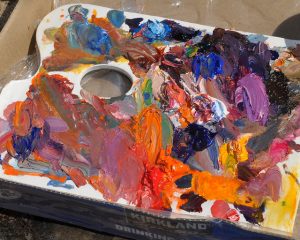Healthy Eating Habits: Shop The Artist’s Palette
 An easy way to make sure your body gets the variety of nutrients it needs is to think of an artist’s or painter’s palette when you shop for groceries and plan meals.
An easy way to make sure your body gets the variety of nutrients it needs is to think of an artist’s or painter’s palette when you shop for groceries and plan meals.
A full artist’s palette contains the colors of the rainbow, plus neutral or earth tones. Our food comes in the same array of colors. By consuming items from across the color spectrum, we also partake of nature’s broad spectrum of nutrients.
The Rainbow Foods
We might, for instance, make a point of having three different colored vegetables on our dinner plate each evening, and enjoying at least two different colored fruits during the day.
- Red and pink foods are loaded with lycopene, beta-carotenes, and vitamin C. Lycopene is a powerful antioxidant, helping to rid our system of the free radicals that harm our cells. Beta-carotene, another antioxidant, changes into vitamin A that supports eye, skin, and muscle function. Vitamin C is necessary for the growth and repair of all our tissues.
- Orange and yellow foods are also bursting with beta-carotene and vitamin C, like the reds and pinks. In the U.S., about half of our vitamin A comes from eating beta-carotene rich foods.
- Green foods give us the antioxidants lutein and zeaxanthin. Lutein protects our eyes from the damaging effects of blue light, and helps prevent cataracts and macular degeneration. Zeaxanthin provides similar eye-health benefits, especially as we age. Dark green veggies are rich in calcium, folate, fiber, potassium, vitamins E and C.
- Blue and purple foods give us vitamin C, a flavonoid called anthocyanin, plus ellagic acid, polyphenols, and antioxidants. Anthocyanin can cross our blood-brain barrier to boost memory and learning capacities. It may also provide anti-viral and anti-inflammatory benefits. Ellagic acid, another antioxidant, seems to promote healthy cell growth.
Typically, the darker and richer a food’s color, the more antioxidants it contains.
The Neutral Earth-Tone Foods
Nature’s white, black, and tan foods are not nutritionally bland. They provide a dazzling array of necessary vitamins, minerals, and other healthy compounds.
- White fruits and vegetables (e.g., bananas, onions, mushrooms) are a great source of the flavonoid quercetin. Quercetin helps reduce the body’s allergic responses, and supports our immune system.
- Tan foods (e.g., wheat, oats, nuts) are generally full of fiber. We need a diet high in fiber to digest our food properly, and lower our risk of heart disease. Many tan foods are also good sources of protein.
- Black foods (e.g., black beans, black pepper, black olives) are treasure troves of various minerals, such as iron and calcium.
- Dark brown foods (e.g., coffee, some tea, dark chocolate) are rich in polyphenols, a form of antioxidant that protects the body from various diseases including osteoporosis, diabetes, and heart disease.
Eating a variety of colorful foods is a general healthy eating guideline, but if you are working with a doctor or dietician on eating disorder issues, or meal planning, be sure to follow their food recommendations.
Source: Chopra
Photo credit: Grand Canyon National Park
 Eating Disorder Self Test. Take the EAT-26 self test to see if you might have eating disorder symptoms that might require professional evaluation. All answers are confidential.
Eating Disorder Self Test. Take the EAT-26 self test to see if you might have eating disorder symptoms that might require professional evaluation. All answers are confidential.